The First CROS Hearing Aids?
Posted on September 5, 2017 at hearinghealthmatters.org. Reprinted with permission.
In 1965, Harford and Barry were credited for the first accessible published description of across-head fitting1. It was called the CROS (Contralateral Routing of Offside Signals). Harford and Barry did acknowledge, however, that Wullstein and Wigand had published results on an almost identical across-head arrangement three years earlier2. The Wullstein and Wigand work has seldom been quoted in related literature in the US, perhaps because it was written in German3. But, were these the first CROS hearing aids?
Eyeglass Hearing Aids
Interestingly, even prior to Wullstein and Wigand’s publication in 1962, across-head hearing aid fittings were common. This concept was incorporated into the first eyeglass hearing aids. This was even prior to Fowler (1960) suggesting that for total monaural hearing loss, that a microphone could be placed on the bad ear side and use a bone-conduction vibrator at the good ear4. (Ken Berger reported that H.J. Salomon et al. in 1965 filed a patent that essentially followed Fowler’s bone vibrator coupled to an off-side microphone – patent #3,183,312).
At least since 1954, a number of hearing aid manufacturers produced eyeglass hearing aids in which both temples were needed to achieve across-head hearing. This was primarily due to the size of components, requiring that some components be placed in each temple, and the two sides hard wired to each other. Eyeglass hearing aids were common at the time as evidenced by the number of companies that made such units, and are listed in the following section. This information on companies and the designation of two-temple requirements for such aids was compiled from Berger’s book on hearing aids3.
Company and Year in Which Across-Head Eyeglass Hearing Aids Were Introduced
- Akumed MGH Glasses – 1954
- Acousticon Model A-235 – 1956
- Amplivox Model SA – 1956
- Ardente Acoustic Laboratories, LTD Model A – 1955
- Auditron (Globe) Model T12 – 1959
- Audivox Model “Spectacular” – 1956
- Aurex Model A400 – 1955
- Beltone Model Virtuoso – 1958
- Bommer Model FM – 1956
- Robert Bosch Elekrtronik Model Hörbrille – 1957
- Danavox International Glasses Model – 1956
- Deutsche Akustik-Gesellschaft Glasses Model – 1958
- Dicton Høreteknik Glasses Model – 1958
- The Dynaphone Co. DynaGlasses Model – 1956
- AG Für Elektro-Akustik Model Visaton – 1956
- Fortiphone LTD Model Spectette – 1956
- Gem Ear Phone Co. Glasses Model – 1957
- Linke-Hörgeräte Glasses Model – 1956
- Magnatone Corp. Model M1 – 1956
- Maico Electronics Model AF Transist-Ear – 1958
- V/O Medexport Model CO-2 – 1958
- Micro-Elektrik Ltd. Model B/05 – 1956
- Microtone Co. Model Vision-Ear Bone-Conduction glasses – 1954
- Otarion Electronics Inc. Model L.10 (Listener) – 1954
- Oticon Eyeglass Model – 1956
- Otoacustica Electronic Products Model Gamma (Telescope) – 1961
- Paravox Hearing Aid Co. Model I-G (I-Glas) – 1955
- N.V. Philips Gloeilampenfabrieken Model KL6100 – 1959
- Polyfon Hearing Aids Ltd. Model Optic Ear – 1958
- Radioear Corp. Model Stereo – 1958
- Rexton Model H-570 Glasses – 1960
- Siemens A.G. Glasses Model – 1957
- Skandiavox Model 60T – 1958
- Telex Corp. Model #44 – 1958
- Toepholm & Westermann A/S Model Sight-N-Sound Glasses – 1959
- Trans-Audio Co., Inc. Model Twin Temples – 1958
- Unex Laboratories, Inc. Model VE (Vision Ear) – 1955
- Wendton Model WT800 – 1955
An example of an across-head eyeglass hearing aid is provided in Figure 1. This is from the author’s collection and shows a Dicton unit from 1958. What follows is a report on this device to assist in explaining how the across-head eyeglass hearing aid was designed.
Author’s Note: What most hearing professionals do not realize is that during the mid 1950s into the early 1970s, eyeglass hearing aids were very much the fitting style. They were the “new” technology. In fact, according to Lybarger, they preceded behind-the-ear hearing aids in development history. (More on this in a later post).
Dicton Høreteknik Model C, Year = 1958
The Dicton eyeglass hearing aid was designed to take sound from one side of the head via a microphone pickup, and transferring sound to the contralateral ear using a wired arrangement through the eyeglass frame and temples to the ear. This was powered with a 625 cell and used an Oticon receiver housed in the off-side module. The hearing aid was manufactured in Copenhagen, Denmark by J. Laurberg Christianson with Skandiavox. It was distributed in the United States by Omega Electronics (Jose Manzini in New Orleans, LA) and in England by Leyton Instrument Company.
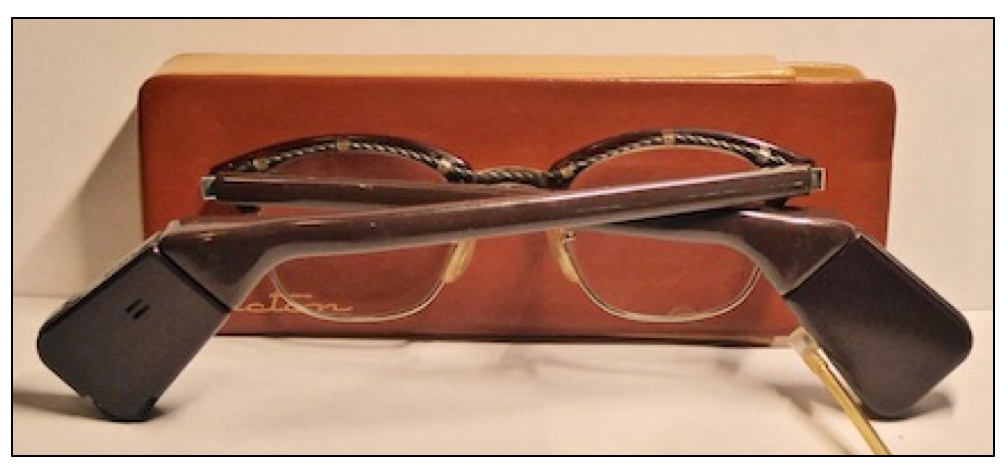
Figure 1. Dicton across-head hearing aid from 1958. The microphone is on one side, along with the amplifier and power supply, and then wired through the eyeglass temple and frame to the opposite side to the hearing aid receiver where the sound is directed to the ear through plastic tubing to an earpiece. (From Staab Collection).
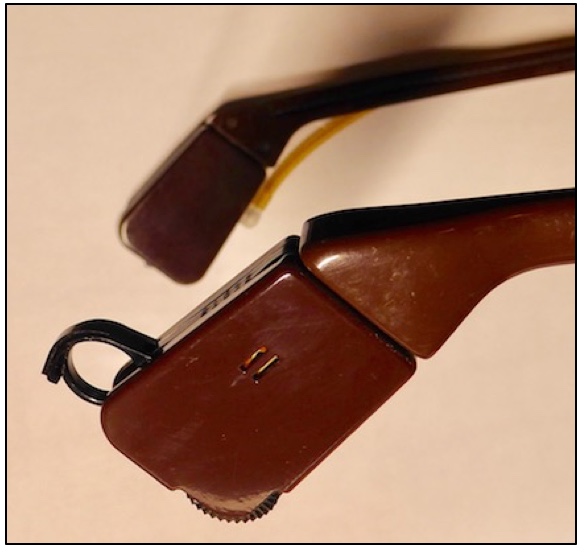
Figure 2. Microphone, power supply, volume control, and amplifier side shown closest. The two small slits are the microphone opening. The battery compartment is open to show its position. It used a 625 cell. The volume control is on the lower back and upon turning it, does not suggest that the volume control also has an ON/OFF switch. There were no other controls. The far image is the other side of the eyeglass hearing aid. That portion contained primarily the receiver. Sound was delivered to the ear through a polyethylene flexible tube ending in some kind of ear piece.
The remainder of this post is to show this across-head hearing aid in some detail because there seems to be little information available on such early across-head eyeglass hearing aids, even though they were quite popular.
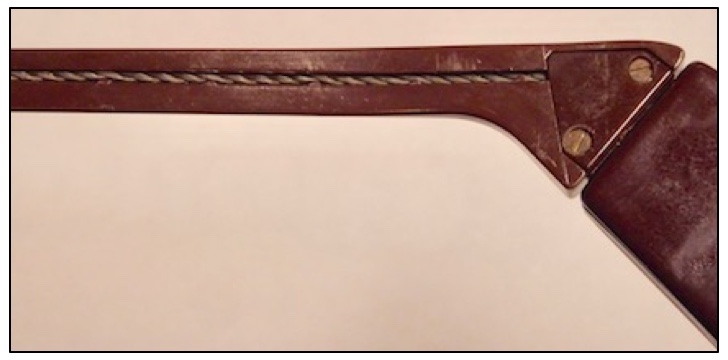
Figure 3. The wiring routing the signal from the microphone/amplifier side is fitted in a groove cut into both eyeglass temples. The plate (identified by the two screws) where the wire is hidden served also to store excess wire when the temple is shortened. No rewiring was required.
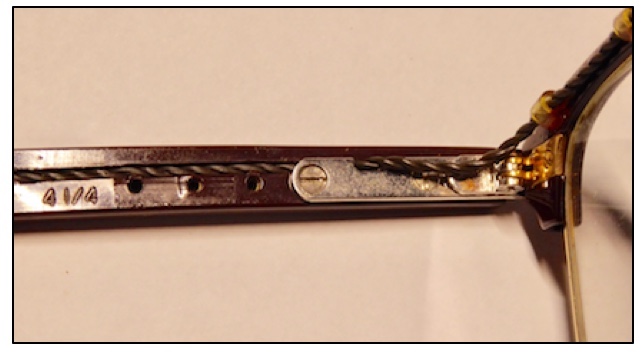
Figure 4. This image shows the wiring through the hinge connection and temple length adjustment. The temple was designed for 4 length adjustments down to 4 and ¼ inches. The screws on the metal portion were moved to one of the 4 pre-drilled and threaded hole options and that part of the temple overlapping the front of the eyeglass was cut off.
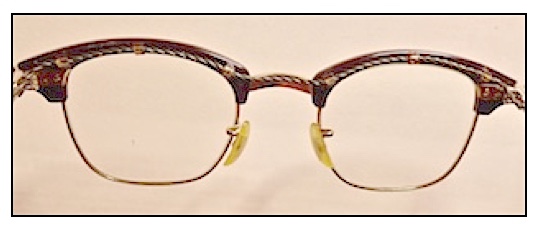
Figure 5. Wiring attached to the back of the eyeglass frames.
Comparison to Later Eyeglass CROS Hearing Aids
A comparison of the Dicton to a later eyeglass CROS hearing aid (Maico Transist Ear, Year = about 1970) is shown in Figure 6.
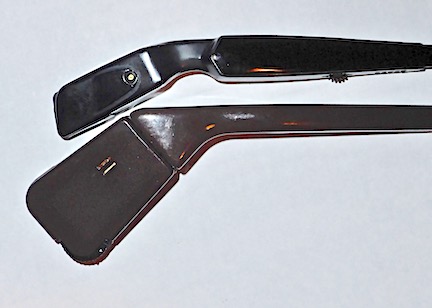
Figure 6. A Maico Transist Ear (top, about 1970 and Dicton (bottom,1958). Aside from size resulting from components, the Dicton had its electronics all in the paddles, with some components in each paddle. The Maico had its amplification forward of that part of the temple that fit over the ear. The volume control wheel is seen at the bottom of the aid, and forward. The microphone remained in the paddle, as identified by the small whitish dot. Because this was a CROS hearing aid, the receiver is in the opposite ear temple. Wiring through the frame was often placed in the groove where the glass fits into the frame (Figure 7).
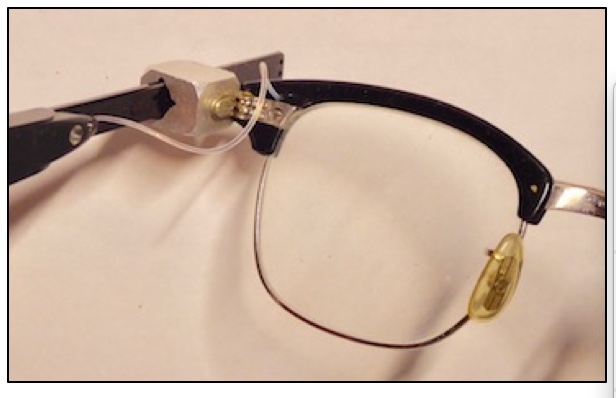
Figure 7. Later models of CROS eyeglass hearing aids used a wire arrangement very similar to that of the Dicton unit. Some dispensers grooved the back of the top of the frame and placed the wires into that groove and covered it with some kind of sealer. At other times, an attempt was made to place the wires in the groove for the glass in the eyeglass frame. The metal piece that the temple slides through was used to determine the temple length.
First Non-Across-Head Eyeglass Hearing Aid
In fact, it was not until 1956 that the first eyeglass temple hearing aid was made that was not an across-head hearing aid. That unit was the Audivox (successor of Western Electric) “Spectacular.” It was a three transistor hearing aid and used a RM400 battery as its power supply (Figure 8 and 9).
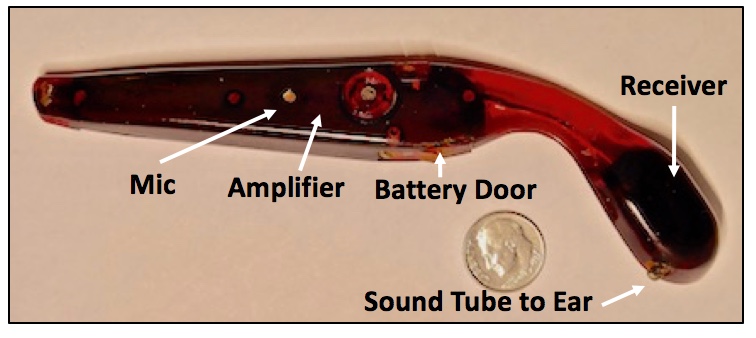
Figure 8. The first eyeglass hearing aid that did not use an across-head arrangement, but placed all components in one temple. This was the Audivox “Spectacular” introduced in 1956.
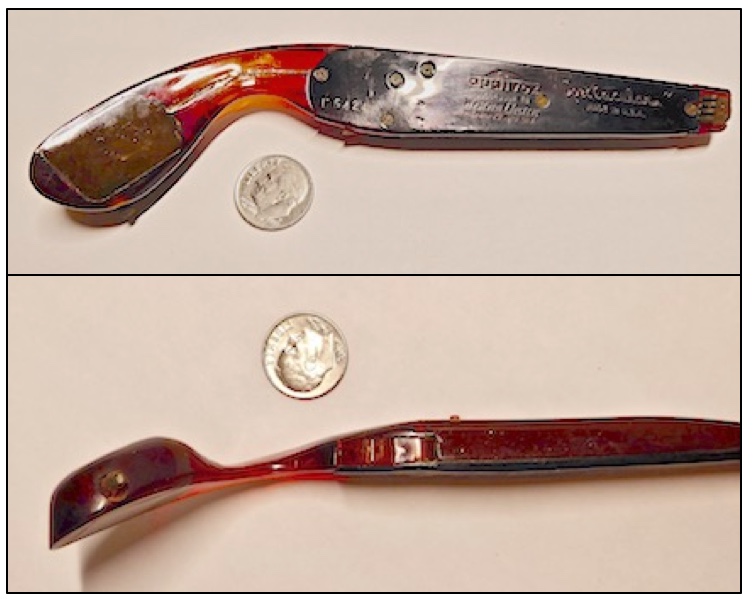
Figure 9. Images from the inside (top) and below (bottom) providing additional views of the locations of components, all in a single temple.
References
- Harford, E., & Barry, J. (1965). A rehabilitative approach to the problem of unilateral hearing impairment: the contralateral routing of signals (CROS). Journal of Speech and Hearing Disorders, 30, 121-138.
- Wullstein, H.L. and Wigand, M.E. (1962). Über Hörhilfe zum Beidseitigen Hören für Einseitig Ertaubte und ihre Voraussetzungen (A hearing aid for single ear deafness and its requirements). Acta Otolaryngologica, 54, 1962, 136-142.
- Berger, K. (1970). The Hearing Aid and its Development. National Hearing Aid Society, Livonia, MI.
- Fowler, E. P. (1960). Bilateral hearing aids for monaural total deafness: a suggestion for better hearing. Archives of Otolaryngology, 72, 1960, 57-58.

